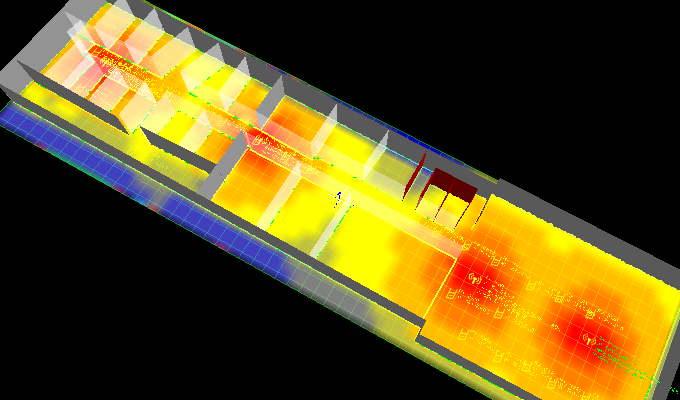
Indoor WiFi Planning, Coverage, Survey & Analysis software tool
EMSlice is an indoor WiFi planning, heatmapping and analysis software tool. EMSlice lets you plan, measure, survey, visualize and troubleshoot indoor WiFi networks. Find WiFi coverage and performance issues, plan connectivity solutions, measure & analyze performance.
WiFi planning, heatmapping, site survey and analysis is essential for planning and supporting indoor WiFi networks. EMSlice lets you test an installed network’s performance, plan a new network, or plan changes to an existing network.
With EMSlice you can:
- Plan an Indoor WiFi network, predicting coverage and performance before installation. Adjusting network configuration and installation parameters, predicting impact on performance before carrying out real life changes.
- Measure, survey and analyse an installed WiFi network’s signal strength (RSSI), coverage and performance. Gathering statistics, preparing heatmap visualizations.
- Importing design data such as building structure and device parameters and positioning. Export network configuration and simulated & measured network coverage & performance.
WiFi planning & heatmapping from simulation
The following is a quick overview of an indoor WiFi plan and heatmap generation from simulation only. This video includes:
- creating a simple building model from a floorplan image
- creating a WiFi RSSI coverage heatmap from simulation
WiFi planning, heatmapping and analysis from survey and simulation
The following is an overview of how to generate a wifi survey, plan and heatmap for an office building. This video includes:
- creating a model of the building
- performing a site survey to generate a heatmap from measurement
- generating a heatmap from simulation/ prediction
- adjusting the WiFi plan parameters
- exporting the results for further analysis
Try EMSlice Today
Click here for options to get our EM Simulation Software for simulation, modelling & analysis.
What is a wifi coverage heatmap?
A WiFi heatmap is a visualisation of the strength and quality of a wifi signal, either throughout a building, urban or rural area. A WiFi heatmap can be based on a set of wifi signal measurements from a site survey, or from a model and simulation of the area.
A heatmap may be based on real world measurements, by using a survey tool such as EMSlice to measure the wifi signal at many locations through an area of interest. Those measurements can be processed to build a map of the actual WiFi signal coverage and quality through the area.
A heatmap can be based on prediction, by building a model of the building or area of interest into an RF simulation software tool such as EMSlice and adding one or more wifi access points to the model, and running the simulations and calculations to predict the wifi signal coverage and quality throughout the environment.
How does a surveyed wifi heatmap work?
A surveyed WiFi heatmap works by using a laptop’s wifi interface to listen for wifi signals that are available, and as the user moves through the environment, those captured signals are added to different locations around an environment of interest. Those captured signals are added to the environment to build up a map of the wifi signals available across the area. The resulting heatmap gives an indication of the coverage achieved by existing wifi networks in the area of interest.
How does a predicted wifi heatmap work?
A predicted wifi heatmap is built on a model of the building including the walls, doors, windows, etc such that the wifi/ radio propagation environment is understood. Once a model of the environment is build into a radio planning tool such as EMSlice, one or more wifi access points are added to the model and a set of simulations and calculations are done to predict the performance and coverage of the planned wifi network.
The simulation is completed by a combination of ray tracing and path loss calculations among others.
Try EMSlice Today
Click here for options to get our EM Simulation Software for simulation, modelling & analysis.
What else is possible?
- For heatmapping of networks in outdoor/ urban or rural areas click here
- For wireless network analysis other than heatmapping, such as propagation analysis and other communication scenarios click here
